
Wednesday May 05, 2004
FLY LOLA B98/10
ROAD ATLANTA ALMS 1999
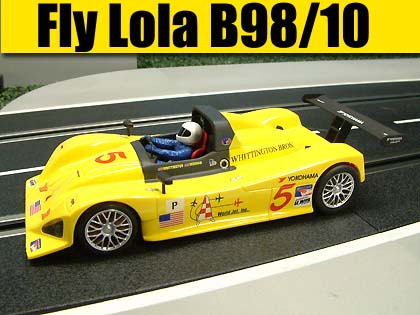 It seems we are finally seeing some new releases arrive to help make this
Spring and Summer even better. Some of these are models that for some reason seem to slip by
un-noticed, without much fan-fare. The Fly Lola B98/10 just might qualify as one
of these "Sleepers", so it might be in your best interest to give it a closer
look.
It seems we are finally seeing some new releases arrive to help make this
Spring and Summer even better. Some of these are models that for some reason seem to slip by
un-noticed, without much fan-fare. The Fly Lola B98/10 just might qualify as one
of these "Sleepers", so it might be in your best interest to give it a closer
look.
First impressions of the model were positive. As I looked around this machine, I was pleased in the efforts made in both the Tampo-stamping and clear-coat. Our model was free of any dirt or dust under this clear-coat, and all markings were very clear and even. The overall shape of the model seem to match prototype photos closely, although from the middle of the body to the rear it seems to have smoother, less distinct line.
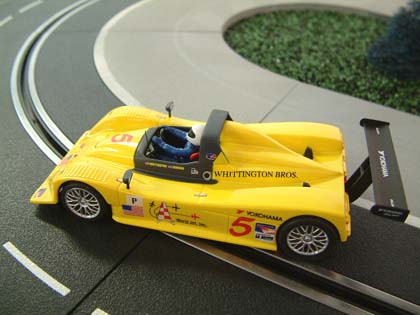
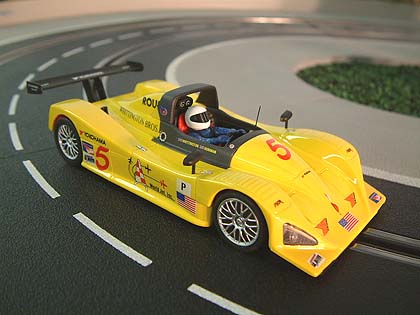
Smaller details such as the mirrors and antenna might fall victim quickly to hard crashes, though without them the model wouldn't look as good as it does. The rear wing is pressed into place, yet has a slight amount of free-play. The durability has yet to show itself but even if it does break loose in a hard crash, I have lived with gluing or removing these small items on other models, so this is no real issue for me. The cockpit interior and driver are standard fare, giving a reasonable impression of the prototype. Body fit to the chassis was very clean, and with the absence of scale detail hidden underneath, allows an easily-reassembly.
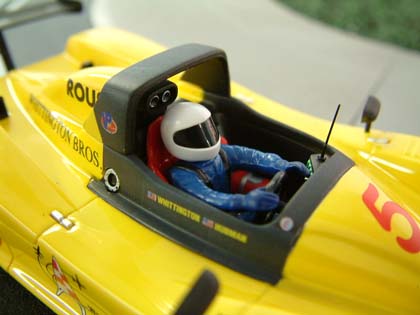
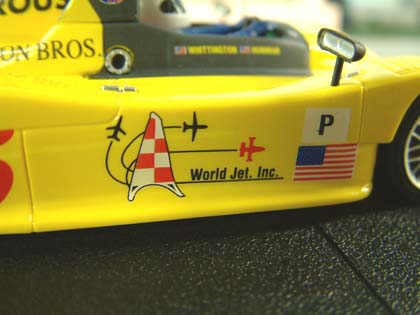
The wheels and tires here are also a good effort although there is a change to the front tires that some may, or may not care for. The tire compound is different than the standard rubber found in the rear, and on most other Fly releases. They are closer to a higher grade silicone, identical to that used on the front of the EVO2 (I swapped these to make sure). Those who are familiar with the Super Tires made my Prospect Park Raceway will find them almost identical in compound. Some scale purists may not like this addition, however the smaller profile of these tires again match the prototype photos closely, although some indicate white letter markings. Up front we see a solid front axle design, which seems to be the identical axle used in the higher end EVO2 and it should please some who do not prefer the plastic post style design.
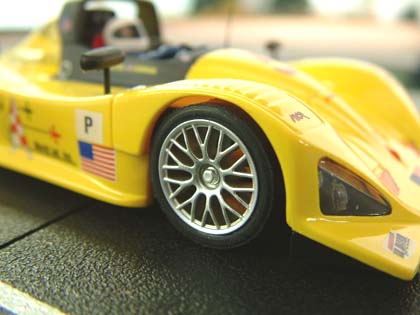
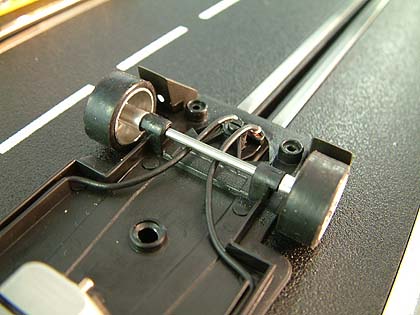
Removing the body from the chassis was a painless procedure with 4 screws used for mounting as shown. Under the hood we see the standard Mabuchi motor in an inline configuration. This set-up worked very well in this model, with very little side-to-side free-play present. Fly stated that there is room to set-up the use of the stronger EVO2 motor if you so desire, although on our smaller home-tracks, the stock motor seems more than enough. I will test this set-up at a later date and pass on my findings. I like the fact Fly molded "gutters" to aid you in clean wire placement, and it also has 2 raised rib sections stemming from the front of the motor to the front axle mounts to help stiffen the chassis and prevent flexing, or at least that is the intent.
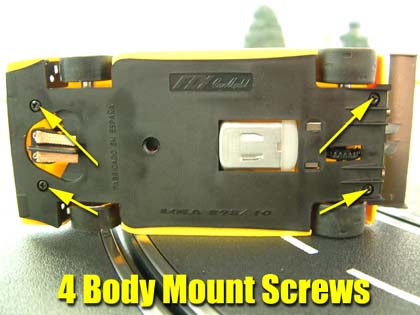
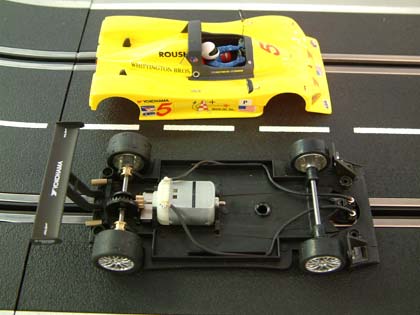
In the rear we see polished rear axle, brass bushings and a 9 tooth pinion turning a 27 tooth crown gear. Once you lubricate the bushings and allow for some break-in time, this model really smoothed out. The bushings were a very tight fit in the chassis, although as usual I added a small drop of Super Glue to make sure they stayed that way. Right behind the motor, we find the familiar Fly B73 bar magnet in an easy to remove magnet pocket.
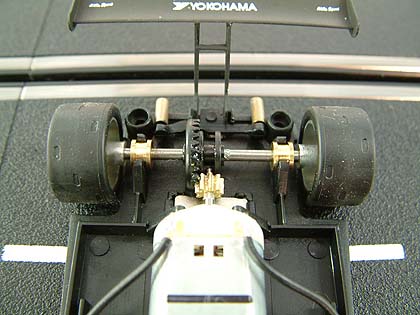
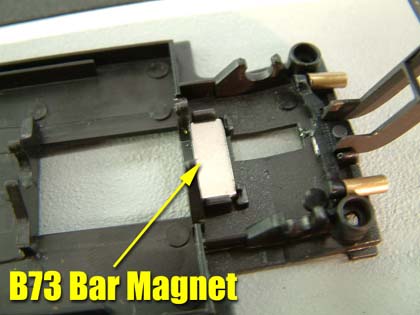
The thing that surprised me was how nicely this model drove out of the box. Aside from the fact it needed a decent break-in to quiet down some, it ran better...or shall I say with less noise...than some of their previous efforts out of the box. After some tire truing and break-in we began to settle down into a good rhythm with this model. Braking, along with acceleration was crisp and even, and punching out of the corners in this model can be serious fun! Braking might appear slightly lighter than you usually find on typical front-motor or sidewinder Fly cars, but what difference there might be is very slight. The B73 bar magnet provides fans of magnetic down-force its usual amount, however there are more tuning potentials here, especially up front for the addition of extra magnets or weight.
In its box-stock form, we were recording lap times on the average of 2.5 seconds according to the DS Timer. Although a logical match would be a second Fly Lola, I decided to test it against the Spirit Lola B2K/10. Given the fact they have the same gear ratio, motor configuration and bar magnet, they were very close. Although the Spirit seems to be slightly more stuck down, its increased wheel-base makes it a little slower in the tight corners. We raced 2 50 laps heats with both of them, swapping lanes at the 25 lap mark. All I can say is we were dead even and had a blast!
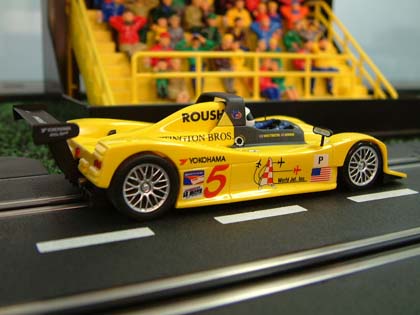 In
the end, I have to say I was very pleased with this effort. Sometimes simplicity
is the best way to go to produce a decent slot car, and Fly has succeeded in
that, at least in my opinion. Although I am not really a fan of the 1:1 series,
this certainly has not stopped us in the past from re-creating it here in our
home racing, and this latest effort by Fly just added one more competitor to our
series. More of these are planned and on the way soon, and I can only suggest
taking a second look at these fine models, you might find them more fun than you
thought!
In
the end, I have to say I was very pleased with this effort. Sometimes simplicity
is the best way to go to produce a decent slot car, and Fly has succeeded in
that, at least in my opinion. Although I am not really a fan of the 1:1 series,
this certainly has not stopped us in the past from re-creating it here in our
home racing, and this latest effort by Fly just added one more competitor to our
series. More of these are planned and on the way soon, and I can only suggest
taking a second look at these fine models, you might find them more fun than you
thought!
Harry
As always feel free to contact me about this article or just the hobby in general at wiseone@yhti.net, or better yet drop into our Message Forum and share your thoughts with other enthusiasts!
Thanks go to FLY CAR MODEL for providing us with this Sneak Preview!
Check their website for all the latest information often!
If your thinking about getting this model, try giving Slot Car World a call and get your pre-order in today!